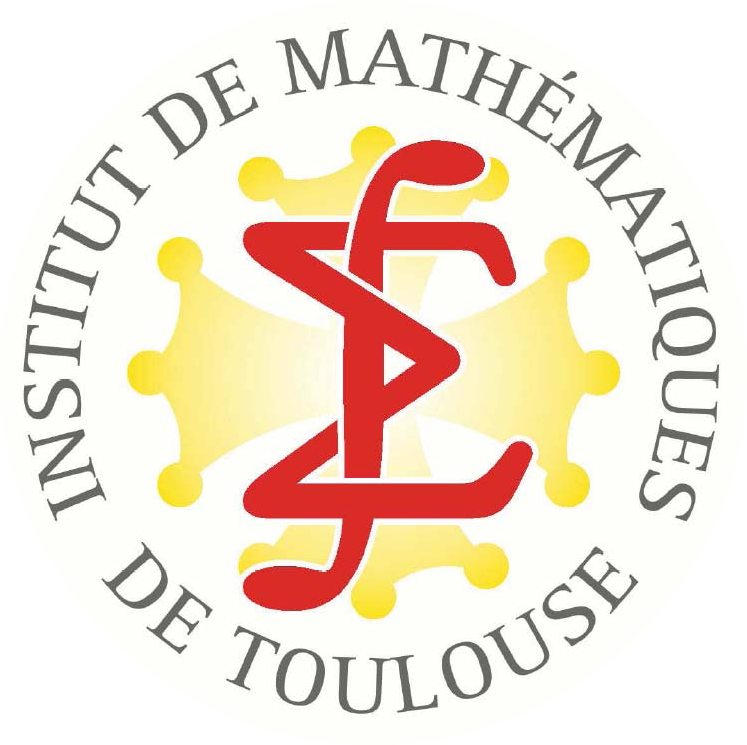This paper deals with rank two connections on the projective line having four simple poles with prescribed local exponents 1/4 and . This Lamé family of connections has been extensively studied in the literature. The differential Galois group of a Lamé connection is never maximal : it is either dihedral (finite or infinite) or reducible. We provide an explicit moduli space of those connections having a free underlying vector bundle and compute the algebraic locus of those reducible connections. The irreducible Lamé connections are derived from the rank regular connections on the elliptic curve ; those connections having a finite Galois group are known to be related to points of finite order on the elliptic curve. In the paper, we provide a very efficient algorithm to compute the locus of those Lamé connections having a finite Galois group of a given order. We also give an efficient algorithm to compute the minimal polynomial for the corresponding field extension. We do this computation for low order and recover this way known algebraic solutions of the Painlevé VI equation and of the classical Lamé equation. In the final section we compare our moduli space with the classical one due to Okamoto.
Dans cet article, nous étudions les connexions de rang deux sur la droite projective ayant quatre pôles simples avec exposants locaux prescrits 1/4 et que nous appelons connexions de Lamé. Cette famille a été maintes fois étudiée dans la littérature. Le groupe de Galois d’une telle connexion n’est jamais maximal : il est ou bien dihédral (fini ou infini), ou bien réductible. Nous produisons un espace de modules explicite pour les connexions de Lamé définies sur le fibré trivial et calculons le lieu algébrique des connexions réductibles. Les connexions de Lamé irréductibles sont obtenues comme images directes sur la droite des connexions régulières de rang définies sur le revêtement double elliptique ; les connexions dont le groupe de Galois est fini sont connues pour être reliées aux points d’ordre fini sur la courbe elliptique. Au cours de l’article, nous produisons un algorithme performant pour calculer le lieu des connexions de Lamé dont le groupe de Galois est fini, d’ordre donné. Nous donnons un autre algorithme calculant de manière efficace le polynôme minimal de l’extension de corps correspondante. Le calcul est effectué pour les ordres petits et nous retrouvons ainsi quelques solutions connues de l’équation de Painlevé VI et de l’équation classique de Lamé. Dans la dernière section, nous comparons l’espace des modules construit avec l’analogue classique dû à Okamoto.
Frank Loray 1 ; Marius van der Put 2 ; Felix Ulmer 1
@article{AFST_2008_6_17_2_371_0,
author = {Frank Loray and Marius van der Put and Felix Ulmer},
title = {The {Lam\'e} family of connections on the projective line},
journal = {Annales de la Facult\'e des sciences de Toulouse : Math\'ematiques},
pages = {371--409},
publisher = {Universit\'e Paul Sabatier, Institut de Math\'ematiques},
address = {Toulouse},
volume = {Ser. 6, 17},
number = {2},
year = {2008},
doi = {10.5802/afst.1187},
mrnumber = {2487859},
language = {en},
url = {https://afst.centre-mersenne.org/articles/10.5802/afst.1187/}
}
TY - JOUR AU - Frank Loray AU - Marius van der Put AU - Felix Ulmer TI - The Lamé family of connections on the projective line JO - Annales de la Faculté des sciences de Toulouse : Mathématiques PY - 2008 SP - 371 EP - 409 VL - 17 IS - 2 PB - Université Paul Sabatier, Institut de Mathématiques PP - Toulouse UR - https://afst.centre-mersenne.org/articles/10.5802/afst.1187/ DO - 10.5802/afst.1187 LA - en ID - AFST_2008_6_17_2_371_0 ER -
%0 Journal Article %A Frank Loray %A Marius van der Put %A Felix Ulmer %T The Lamé family of connections on the projective line %J Annales de la Faculté des sciences de Toulouse : Mathématiques %D 2008 %P 371-409 %V 17 %N 2 %I Université Paul Sabatier, Institut de Mathématiques %C Toulouse %U https://afst.centre-mersenne.org/articles/10.5802/afst.1187/ %R 10.5802/afst.1187 %G en %F AFST_2008_6_17_2_371_0
Frank Loray; Marius van der Put; Felix Ulmer. The Lamé family of connections on the projective line. Annales de la Faculté des sciences de Toulouse : Mathématiques, Série 6, Tome 17 (2008) no. 2, pp. 371-409. doi : 10.5802/afst.1187. https://afst.centre-mersenne.org/articles/10.5802/afst.1187/
[1] Barth (W.) and Michel (J.).— Modular curves and Poncelet polygons, Math. Ann. 295, 25-49 (1993). | MR | Zbl
[2] Berkenbosch (M.) and van der Put (M.).— Families of linear differential equations on the projective line, Groupes de Galois arithmétiques et différentiels, 39-68, Sém. Congr., 13, Soc. Math. France, Paris, 2006. | MR | Zbl
[3] Beukers (F.).— Solutions of a Lamé system private notes, November 10 2004.
[4] Beukers (F.) and van der Waall (A.).— Lamé equations with algebraic solutions, J. Differential Equations 197, 1-25 (2004). | MR | Zbl
[5] Chiarellotto (B.).— On Lamé Operators which are Pullbacks of Hypergeometric Ones, Trans. Amer. Math. Soc., Vol 347, 2735-2780 (1995). | MR | Zbl
[6] Hitchin (N.J.).— Poncelet Polygons and the Painlevé Equations, Geometry and analysis (Bombay, 1992), 151–185, Tata Inst. Fund. Res., Bombay (1995). | MR | Zbl
[7] Hitchin (N.J.).— Twistor spaces, Einstein metrics and isomonodromic transformations, J. Differential Geometry 42, 30-112 (1995). | MR | Zbl
[8] van Hoeij (M.) and van der Put (M.).— Descent for differential modules and skew fields, J. Algebra 296, 18-55 (2006). | MR
[9] Inaba (M.), Iwasaki (K.) and Saito (M.).— Dynamics of the Sixth Painlevé equation, Théories asymptotiques et équations de Painlevé, 103-167, Sémin. Congr., 14, Soc. Math. France, Paris, 2006. | MR
[10] Jimbo (M.) and Miwa (T.).— Monodromy preserving deformations of linear ordinary differential equations with rational coefficients II, Physica 2D, 407-448 (1981a). | MR | Zbl
[11] Lang (S.).— Elliptic curves : Diophantine analysis, Grundlehren no 231 (1978). | MR | Zbl
[12] Manin (Yu.I.).— Sixth Painlevé equation, universal elliptic curve, and Mirror of , AMS Transl. (2) 186, 131-151 (1998). | MR | Zbl
[13] Mazzocco (M.).— Picard and Chazy solutions to the Painlevé VI equation, Math. Ann. 321, no 1, 157-195 (2001). | MR | Zbl
[14] Merel (L.).— Bornes pour la torsion des courbes elliptiques sur les corps de nombres, Invent. Math., 124, 437-449 (1996). | MR | Zbl
[15] Okamoto (K.).— Sur les feuilletages associés aux équations du second ordre à points critiques fixes de P. Painlevé Japan J. Math. 5, 1-79 (1979). | MR | Zbl
[16] Okamoto (K.).— Studies on the Painlevé equations I. Sixth Painlevé equation , Ann. Mat. Pura Appl. (4), 146, 337-381 (1987). | MR | Zbl
[17] Picard (É.).— Mémoire sur la théorie des fonctions algébriques de deux variables, Journal de Mathématiques Pures et Appliquées, 5, 135-319 (1889). | EuDML | JFM
[18] Saito (M.-H.) and Takebe (T.).— Classification of Okamoto-Painlevé pairs, Kobe J. Math., 19, 21-50 (2002). | MR | Zbl
[19] Saito (M.-H.) and Terajima (H.).— Nodal curves and Riccati solutions of Painlevé equations, J. Math. Kyoto Univ., 44-3, 529-568 (2004). | MR | Zbl
[20] Sakai (H.).— Rational surfaces associated with affine root systems and geometry of the Painlevé equations, Comm. Math. Phys., 220, 165-229 (2001). | MR | Zbl
[21] Silverman (J.H.).— The Arithmetic of Elliptic Curves, GTM 106, Springer Verlag (1986). | MR | Zbl
[22] Singer (M.F.).— Moduli of Linear Differential Equations on the Riemann Sphere, Pac.J. Math., 160, 343-395 (1993). | MR | Zbl
[23] Trager (B.M.).— Integration of algebraic functions, Ph.D. Thesis M.I.T., September (1984).
[24] Washington (L. C.).— Elliptic Curves , Chapman-Hall (2003). | MR | Zbl
Cité par Sources :




